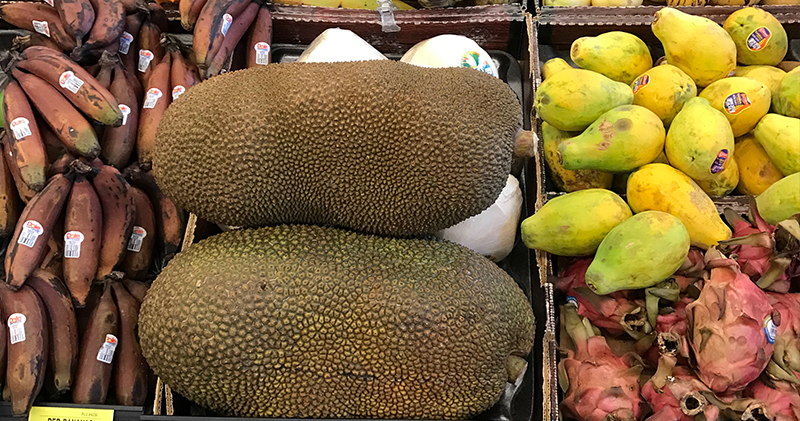I am learning some new skills in my retirement, one of them is occasionally going grocery shopping. It is not that I never shopped before, but it was always with specific directions. I would dash in, circle the store in a frenzy to find the items, and dash out. I now take my time and actually shop. I saw this really unusual item in the produce isle. A young boy and his father were fixated on the same item. I took the picture and googled the information. A jackfruit is a huge, spined, oval fruit that is believed to have been first cultivated in Indian rainforests. The jack tree or Jak is a species in the fig, mulberry, and breadfruit species. The fruit is mostly grown in tropical climates and is the largest tree borne fruit in the world weighing up to 80 pounds. The fruit gets a “bad” odor rap when it is ripening but the meat and seeds are nutritious and edible. The fruit has a distinctive sweet and fruity aroma with flavor comparable to a combination of apple, pineapple, mango, and banana. Jack is the national fruit of Bangladesh. I plan to try it next time I see it at my local Albertson’s.
I attended the initial meeting of the Governor’s Task force on Higher Education. The group is led by Bob Lokken and Linda Clark and includes 37 diverse stakeholders. It is an honor to serve Idaho with a focus on reaching the State’s education goal of 60 percent higher educational learning achievement. Rod Gramer, CEO of the Idaho Business for Education group, recently highlighted a Lumina Foundation report. The data says that only 37.7 percent of Idaho’s citizens hold an education credential higher than a high school diploma. That places Idaho 46th among the states with only West Virginia, Nevada, Alabama, and Mississippi behind us. We know that future Idaho jobs and our economic prosperity are tied to a skilled work force so we can retain and attract companies in Idaho. Mr Gramer reminds us that Idaho’s employers need between 60-68 percent of the workers to hold a post-secondary degree by the year 2020. The other troubling finding is that Idaho’s percentage has stayed relatively flat for seven years in spite of our focus on the sixty per cent goal. Narrowing the gap is going to take innovation – educating on why a post-secondary credential is critical and then providing affordable access. The current system is effective for many but can it be improved? Wish us well and know that your input and voice are needed as we consider options and eventually execute on recommendations.
I attended another meeting this week also related to education. One of our Board Members made the comment that organizing a group was “like trying to trap jackrabbits on a flatbed truck.” May your day be filled with challenging but not impossible tasks.
Mike

